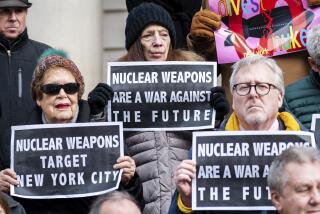Nuclear Warriors Remain at the Ready
- Share via
GROVER, Colo. — In a sealed capsule 100 feet beneath the flat, barren plain in north-central Colorado, Air Force Capt. Xavier Chavez stands ready for war. His weapons: 10 nuclear-armed intercontinental ballistic missiles whose awesome killing power can be unleashed with a flick of the wrist.
Nuclear warriors? These days?
Much has been made of the demise of the Cold War and, with it, the end of a decades-long U.S.-Soviet nuclear standoff. Less noticed is the fact that the U.S. Air Force still has its missiles cocked and ready for a potential nuclear conflict.
The Pentagon also is quietly investing billions to modernize the missile force even as some say the time is fast approaching to eliminate the entire ICBM arsenal.
“It’s a big deal because it’s our national security,” Chavez says as he and his partner, 2nd Lt. Jerome White, wind up a 24-hour subterranean shift monitoring the electronic pulse of triple-warhead Minuteman III nuclear missiles.
“Some people may find that kind of corny, but we have to take it seriously,” says Chavez, 32, looking all business in his blue Air Force jumpsuit.
To watch Chavez and White at their launch control panels is to know that they take their work seriously. Although no nuclear missile has ever been launched other than for testing, it is their duty to ensure their weapons are ready should the call ever come. They make clear they dearly hope it never does.
“Sometimes when it gets quiet in here you think about that,” Chavez says. “You ask yourself, could you do it? It’s something in every crew member’s mind.” He quickly adds that he is sure he could flip the switch if ordered.
Under a 1994 U.S.-Russian agreement, the two nations no longer aim their long-range nuclear missiles at each other. America’s missiles are set on a trajectory that ends in the ocean, but that is not as comforting as it may sound. Pre-programmed wartime targets are kept in the missiles’ memory banks and can be swapped for the ocean targets in 10 seconds. Same for the Russian missiles.
To actually launch an ICBM, a “hot time,” or launch time, must be entered by computer and the missile then must be “enabled”--akin to cocking a revolver before squeezing its trigger. In the final step, Chavez and the crewmate seated beside him would turn their dual keys in unison, as would two officers from a second capsule. Once all four had done so, there would be no stopping the launch.
Keeping the most powerful weapons ever devised at the razor’s edge of readiness is not cheap. The Brookings Institution, a think tank in Washington, calculates from Defense Department budget data that it costs more than $800 million a year to operate and maintain the full fleet of ICBMs.
The Pentagon is investing $5 billion on a missile modernization program to extend the Minuteman IIIs’ useful lives to 2020. It already has spent $650 million to install a new computer system inside the launch capsules, and it intends to replace the Minuteman III guidance and propulsion systems over the next several years.
Chavez and the 280 other ICBM crew members of the 90th Missile Wing don’t think of themselves as merely baby-sitters for these weapons of mass destruction.
On a recent morning at their weapons stations inside the buried capsule that Chavez likens to a “hollowed-out watermelon,” he and White were in almost constant motion, using their newly modernized computer consoles to conduct routine checks of the alarms and sensors that keep the site secure. They also were in contact with other capsule crews and with security police topside.
“There is no room for complacency,” Chavez says.
Inside the climate-controlled launch capsule there is no sense that these military personnel are anticipating nuclear war. Far from it. In the calm professionalism of Chavez and other missileers--as they call themselves--there is a quiet confidence, a practiced precision, a workaday approach they believe will keep nuclear war at bay.
“We’re the biggest kid on the block,” says Capt. Scott Sanders, a soft-spoken launch control officer who has been operating ICBMs in the 90th Missile Wing for 3 1/2 years. “It’s a deterrent--you hope nobody wants to mess with us.”
Nuclear war may be less likely now than during the Cold War, but the Air Force sees no sense in scrapping the 550 ICBMs it operates from underground silos in Montana, North Dakota, Wyoming, Colorado and Nebraska. Two hundred of those are operated by Chavez’s unit, the 90th Missile Wing based at F.E. Warren Air Force Base, Wyo.
The ICBMs form one leg of the military’s “triad” of nuclear forces. The other legs are Air Force B-52 and B-2 bombers and the Navy’s Trident nuclear submarines.
Bruce Blair, a former missileer and now a nuclear expert at the Brookings Institution, says that as arms control treaties further reduce the U.S. nuclear arsenal the favored weapon to keep will be the Navy’s sub-based missiles.
“The ICBM will come under increasing pressure to go away,” Blair says.
The Air Force’s arsenal already is shrinking. As a result of the 1991 Strategic Arms Reduction Treaty, the ICBM force was reduced from 1,000 missiles and 2,450 warheads to today’s total of about 550 missiles with 2,000 warheads.
If the 1993 START II accord is ratified by the Russian Parliament, the Air Force will eliminate its most modern ICBM, the 10-warhead Peacekeeper, and convert the three-warhead Minuteman III missiles to single-warhead missiles. The result would be a force of 500 missiles and 500 warheads.
Even more of the missiles might be eliminated if, as proposed by President Clinton and President Boris Yeltsin at their Helsinki summit in March, a third START agreement is negotiated and put into effect early in the 21st century.
The Air Force officers who manage the missile force argue--not surprisingly--that it makes a unique and critical contribution to the nation’s security.
“There is still in Russia the [nuclear] capability to destroy the United States,” says Col. Tucker Fagan, vice commander of the 20th Air Force, which oversees the entire ICBM force.
Fagan says missileers like Chavez are regularly reminded of this and told that ICBMs are a kind of insurance policy against the possibility that Russia’s experiment in democracy goes bad. But he acknowledges that the missile crews also understand that the days of the ICBM force may be numbered.
“Does that play on their brains? I’m sure it does,” Fagan says.
But morale is high, says Col. Roger Burg, commander of the 90th Operations Group at F.E. Warren. He tells his troops that although their work is sometimes mundane and rarely rewarded with public attention, they should see themselves as warriors, as the ultimate defenders of the American homeland.
Burg bristles at the suggestion that he and his crews are removed from the risk of combat.
“Me, I’m either here or somebody is inhaling my ashes in Minneapolis,” he says.
More to Read
Sign up for Essential California
The most important California stories and recommendations in your inbox every morning.
You may occasionally receive promotional content from the Los Angeles Times.










